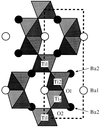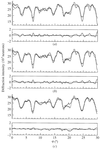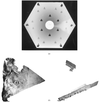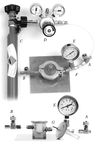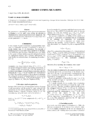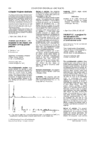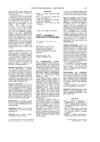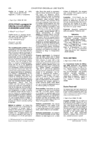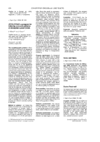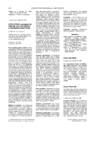issue contents
October 1998 issue

Cover illustration: Powder diffraction pattern of LaB6 obtained using a 200 × 400 mm flat imaging plate mounted at an angle of 45° with the incoming X-ray beam. Experimental conditions: ![[lambda]](/logos/entities/lambda_rmgif.gif) = 0.8884 Å, D0 = 104 mm, exposure time 60 s. Courtesy of Poul Norby.
= 0.8884 Å, D0 = 104 mm, exposure time 60 s. Courtesy of Poul Norby.
research papers
An automatic method for the estimation of the parameters of the trace of the Debye–Scherrer cones on a two-dimensional detector and for integrating the intensity along the Debye–Scherrer cones is presented.
The structure of the 8.4 Å hydrated and dehydrated nacrite was determined by X-ray diffraction.
Synchrotron high-resolution X-ray powder diffraction was applied to analyse structural behaviour of the perovskite-type solid solution of (Nd, Sm)AlO3. A very small change in ionic radius of R gives a remarkable effect on the structure.
A wide-bandpass synchrotron X-ray monochromator with a pair of synthetic multilayers has been characterized and utilized for small-angle X-ray scattering studies of biological fibers, lipid and protein solutions. It provides an increase in flux by a factor of 10–30 compared with an Si(111) monochromator. The wide-bandpass monochromator produces no change in background level nor in small-angle resolution; there is an insignificant degree of diffraction peak broadening.
Ceramics of strontium barium niobate were investigated by transmission electron microscopy; the lowest order incommensurate superstructure (ICS) modulation was observed inall samples. Transparent ceramics which exhibited large grains were characterized by a shortened c axis and higher order ICS reflections.
The accuracy of site-occupancy results for light atoms obtained from powder X-ray data refinements was investigated for the case of the oxygen-deficient 6H-hexagonal ferrites, BaFe0.67Ti0.33O3 − δ (δ = 0.08 and 0.32).
Bragg diffraction from an Ag/Ni multilayer was used to determine independently both the real and imaginary parts of the anomalous scattering factor (ASF) around the Ni LIII and LII edges in the soft-X-ray range. Huge resonant variations were observed with  reaching 55
reaching 55 and
and  decreasing to −63
decreasing to −63  at the Ni LIII edge.
at the Ni LIII edge.
The Hamilton, Rollett and Sparks procedure for scaling frames of X-ray area-detector data has been generalized to utilize partial reflections. The new scaling methods have been shown to work successfully on data-sets collected from crystals of biological macromolecules.
Refinement of the Ferri- and Paramagnetic Phases of Magnetite from Neutron Multiple Diffraction Data
Structural parameters for the ferri- and paramagnetic phases of magnetite have been refined from neutron multiple diffraction (NMD) data. The refinements were done by comparing experimental NMD patterns, obtained with a single crystal of this compound, at room temperature for the ferrimagnetic phase and at 976 K for the paramagnetic phase, with corresponding simulated patterns.
High angular sensitivity is obtained in white-beam topographs made on a weak reflection when it is enhanced through Umweganregung by strong reflection.
The focusing mirrors described here used with low-power microfocus X-ray tubes in single-crystal diffractometry can produce a flux at the sample which is comparable with that obtained with conventional X-ray sources at a power 100 times greater.
A novel technique for obtaining neutron spectra is described. It is applied in a simultaneous diffraction experiment at 32 positions over the thickness of a sample. Comparison of the results with those of a reference experiment with a slightly different geometry reveals the lattice deformation over the sample thickness.
The anisotropy of the intermolecular interactions in the low-temperature ordered phases has been studied for three chemically and structurally related compounds: (CH3)2C(CH2OH)2, (CH3)3C(COOH) and (CH3)3C(CH2OH). The volume expansivity and the packing coefficient have also been studied, both as a function of temperature, in the low- and in the high-(orientationally disordered)-temperature phases of these compounds.
Experimental and data reduction procedures that optimize sample environment and data collection are described. These procedures are structured to the CCP13 standard and are of general applicability in X-ray and neutron fibre diffraction experiments.
Growth histories of various kinds of (111) contact twins in natural diamond have been deduced from X-ray topographic studies.
Interpenetrant cubes of natural diamond have been formed by fibrous  growth upon a twin origin.
growth upon a twin origin.
Anomalous small-angle X-ray scattering revealed the microstructure of the transition metal particles in co-sputtered Ag–20 (and 35) at.% Co and Ag–20 (and 35) at.% Ni in the as-deposited state and after different anneals for 10 min at 573, 623 and 723 K.
With only a powder sample available, resonant (anomalous) scattering of X-rays from a synchrotron source can be used to determine phases of structure factors directly and thus can be used for the ab initio structure determination of unknown crystal structures. The method is described in detail using the orthorhombic structure of SrSO4 as an example.
A method using multi-start simulated annealing refinement followed by structure-factor averaging is presented. Electron-density maps calculated using the average structure factor show less model bias than those computed from individual models.
A kind of polycapillary X-ray optics has been applied to data collection for protein crystals, and much better quality intensities could be obtained than those achieved with Supper double focusing mirrors on the same laboratory X-ray source.
cryocrystallography papers
A pressure cell is described for binding xenon to protein crystals mounted in freely suspended thin films prior to flash cooling, thus trapping the xenon in the crystals.
An open-flow helium cryostat for single-crystal X-ray diffraction experiments capable of reaching 14 K has been developed using off-the-shelf components.
short communications
A new method of calculating the mean orientation is presented.
The harmonic content of back-reflection X-ray topographs of SiC single crystals taken using synchrotron white-beam radiation is analyzed with respect to the origins of the contrast of this kind of topograph.
An electrochemical cell has been constructed for in situ neutron diffraction studies of lithium insertion/extraction processes in electrode materials for Li-ion batteries.
computer program abstracts
PC programs for the display and simulation of X-ray powder patterns are presented.
A graphical program for maps of bond-valence sums is presented.
A software package for mathematical crystallography is presented.
A program for indexing zone-axis patterns of decagonal quasicrystals is presented. It is based on the algorithms of Singh and Ranganathan.
notes and news
Free 

books received
Free 



 journal menu
journal menu














